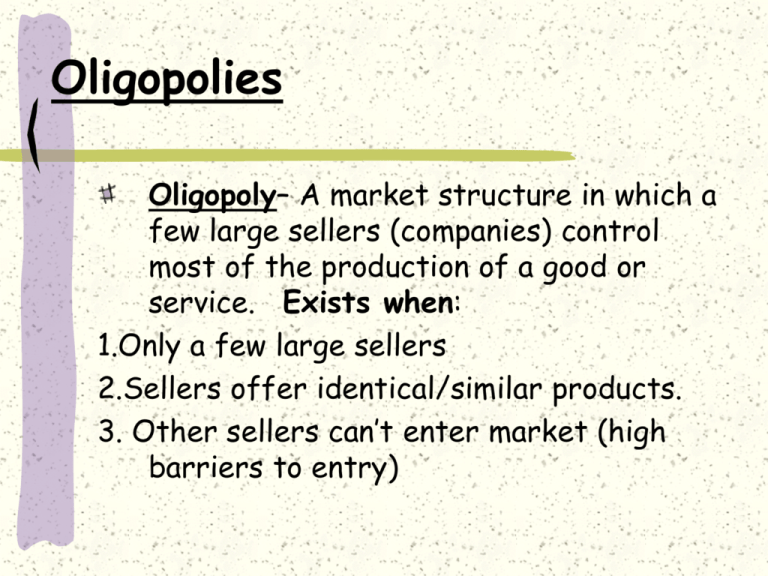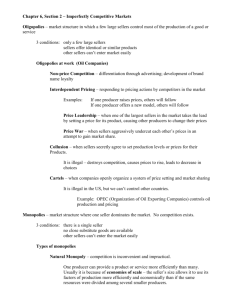Market Structures
advertisement

Oligopolies Oligopoly– A market structure in which a few large sellers (companies) control most of the production of a good or service. Exists when: 1.Only a few large sellers 2.Sellers offer identical/similar products. 3. Other sellers can’t enter market (high barriers to entry) Imperfectly Competitive Markets Note: Ex. Cable TV companies— Market dominated by one or two sellers. Fewer sellers=fewer products and less choices for consumers. Note: Imperfectly competitive structure usually means higher prices! Oligopolies 1. Few Large Sellers—No other market structure has this feature. A market is considered an Oligopoly when the largest 3-4 sellers produce 70% or more of the product. 2. Identical or similar products—Sellers have so much at stake they are less likely to take risks.(Lose mkt. Share). Oligopolies 3. High Barriers to Entry—A few sellers can maintain control only if other sellers cannot enter the market. Why difficult to enter: High start up costs Government regulations Consumer Loyalty Oligopolies at Work Forms of NonPrice Competition—Sellers try to control market by a lot of advertising and through brand loyalty. Ex. Breakfast cereals—Only 3 companies control the market(80% of market). Coca Cola/Pepsi—”Cola Wars”—Big advertising Interdependent Pricing—Pricing depends a lot on pricing of competitors. Price Leadership—Market leader sets prices and the rest follow. Oligopolies at Work— Price War—A failed pricing policy may spark a price war where sellers aggressively undercut each others prices in an attempt to gain market share. Can severely hurt sellers and after the war prices generally rise again. Oligopolies at Work Collusion—When sellers secretly agree to set production levels or prices for their products.—Illegal in U.S.! Cartels—Companies openly organize a system of price setting and market sharing. Illegal in U.S.! OPEC (Organization of the Petroleum Exporting Countries). Set production levels as a means of controlling oil prices. Monopolies Monopoly—A single seller (company) dictates all production of a good or service.—(Opposite of perfect competition). Monopoly exists when: 1. Single seller 2.No close substitute available 3. Complete barriers to entry 4. Complete control over pricing Types of Monopolies 1. Natural—The sellers large size allows for more efficient use of resources. Ex. Utility companies Ex. Cable TV companies Immense start up costs Economies of Scale: Can make a profit only when producing large quantities Types of Monopolies Geographic Monopolies—Markets potential limited by geographic location. Ex. A general store in a remote area Technological Monopolies—A producer develops a new technology that enables the creation of a new product. Ex. Gore-Tex material (Waterproofing). Types of Monopolies Government Monopolies—Any market in which a government is the sole seller of a product. Building roads, bridges, canals, sewer services, water plants, etc. Note: Patents—Exclusive rights to an invention or discovery for 20 years. Copyright: Artists/musicians works protected for the lifetime of the author plus 70 years









